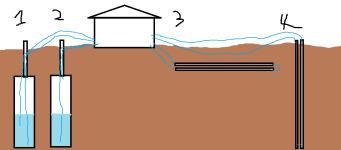Here's a shot of the pump that was installed with my system. This is for 8 tons of cooling. I have a similar pump center for a 3 ton, and the only difference is it has only one pump on it.
The brass circles on the right are valves that come out on sides (well, top and bottom in this pix) that allow the water to be pumped in, air pumped out, and allow the methanol to be added to the system (as an antifreeze).
These are 240V pumps. They are labeled as drawing 1.8 amps each, listed as 377 Watts (yeah, the math doesn't quite work out....). You can also see the valves so you can work either the heat pump or the field independently.
IIRC, the system is pressurized at about 50 PSI. The two lines go outside, and the manifold pit is buried. It's clear from various posts that how and where the manifold is done varies greatly, and it's not too hard to figure out the pros and cons of each approach.
The wires above are not related, they go to the outbuilding. You can see the bottom of the gas tubes (just like telephone company uses) at the top of the picture. It was a big win running 5 3" pipes for 80 feet so they were way outside the perimeter of the house. It let this field be installed after construction, and let me get things to the outbuilding. I also ran a 3" electrical conduit. I mention this because nature abhors a vacuum, so while the ground is open thing about if there is anything else you want to put in there.
Pete
Hi Pete,
What I'm weighing is the difference in cost on a daily basis for a field or my well. That is, does the well that has higher temps(~55F) and the need to pump water up 175 feet every time the system calls for it cost more or less to run than pipes run out in my field or pond that are 6 to 7 feet down but only run ~42F? Also the fact that if there's a failure your pulling your well pump up.
Rob
